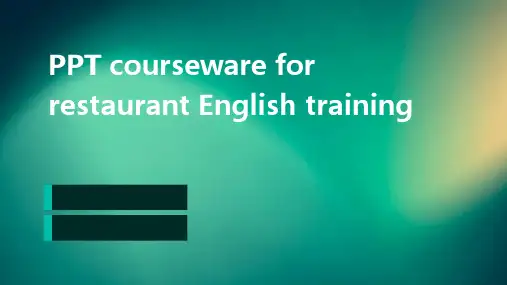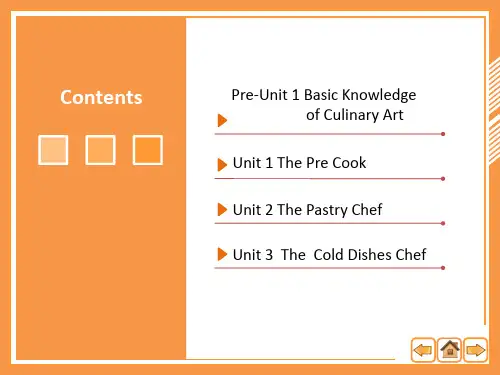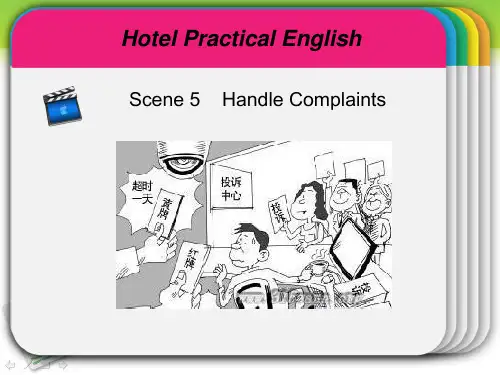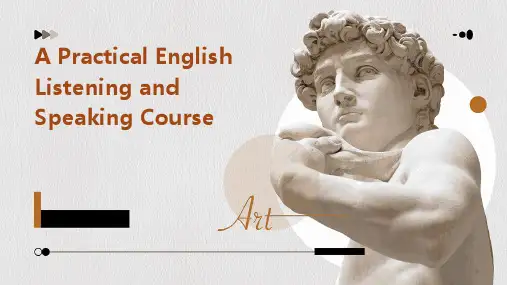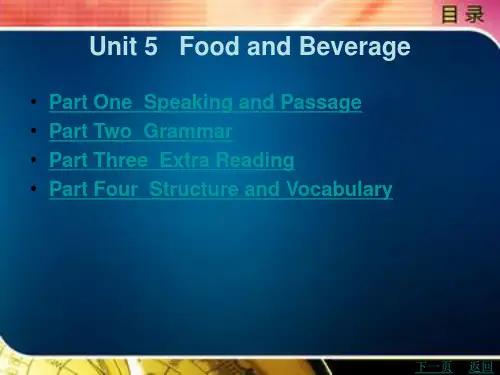饭店实用英语课件part5
- 格式:ppt
- 大小:2.24 MB
- 文档页数:24
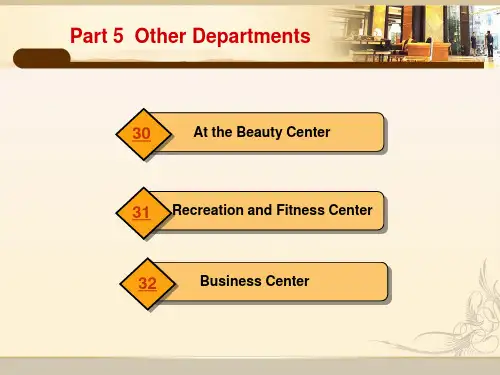
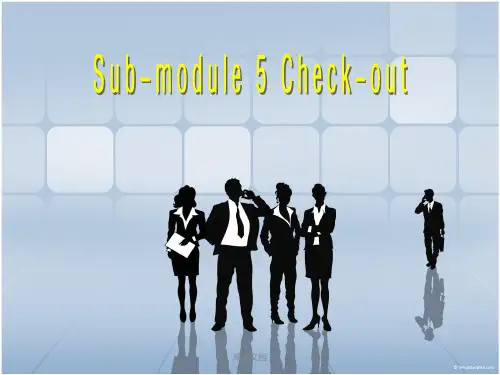

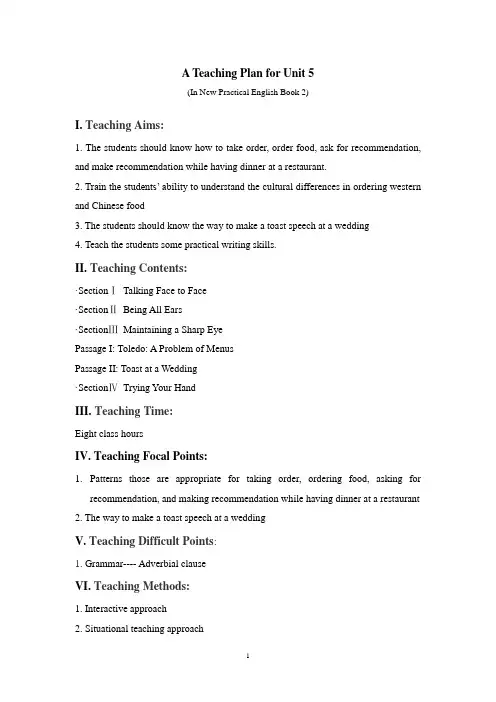
A Teaching Plan for Unit 5(In New Practical English Book 2)I. Teaching Aims:1. The students should know how to take order, order food, ask for recommendation, and make recommendation while having dinner at a restaurant.2. Train the students’ ability t o understand the cultural differences in ordering western and Chinese food3. The students should know the way to make a toast speech at a wedding4.Teach the students some practical writing skills.II. Teaching Contents:·SectionⅠTalking Face to Face·SectionⅡBeing All Ears·SectionⅢMaintaining a Sharp EyePassage I: Toledo: A Problem of MenusPassage II: Toast at a Wedding·SectionⅣTrying Y our HandIII. Teaching Time:Eight class hoursIV. Teaching Focal Points:1.Patterns those are appropriate for taking order, ordering food, asking forrecommendation, and making recommendation while having dinner at a restaurant 2. The way to make a toast speech at a weddingV. Teaching Difficult Points:1. Grammar---- Adverbial clauseVI. Teaching Methods:1. Interactive approach2. Situational teaching approach3. Teamwork method4. Task-based teaching methodⅦ. Teaching Aids:Tape-recorder, BlackboardⅧ. Teaching Procedure1. The first two-class-hour session for SectionⅠ Talking Face to Face.2. Next two-class-hour session for SectionⅡ Being All Ears.3. The next four-class-hour session for SectionⅢ Maintaining a Sharp Eye.4. The fifth two-class-hour session for Section ⅣTrying Your Hand. Section I T alking Face to Face(two-class-hour)1. Read the samplesFind out useful expressions in Dialogue 1 Are you ready to order?. Sentences used in taking order①.Are you ready to order now?②.How would you like that?③.Would you like a baked potato or French fries with that?④.What would you like to drink?⑤.What are you having?⑥.Anything to drink?Sentences used in ordering food①.I’ll have the New Y ork steak.②.What’s the soup of the day?③. I’ll have a cup of that.④. I’d also like a chef’s salad.⑤. Just water, please.Find out useful expressions in Dialogue 2 I want the steak dinner Sentences used in taking order①.May I take your order?②.What do you prefer, soup or salad?③. We have vegetable soup and onion soup.④.What would you like for dessert?Sentences used in ordering food①.I want the steak dinner.②.Bring me a bottle of wine and a glass of water.③. I order my steak rare or medium.④.May I have some more bread and some more water, please?⑤.Nothing, thank you.2. Act outRole playMake up dialogues for ordering some typical Chinese food for your foreign friend and asking to go Dutch with your friend who wants to pay the bill for both of you.Section II Being All Ears(two-class-hour)1. DialoguePre-listening taskRead the printed materials in Listen and Decode in ONE minute.While-listening task①. Listen to the tape WITHOUT looking at the book.②. Listen to the tape one sentence after another, taking notes during the pause.③. Repeat the sentences after the tape.Dialogue scriptKim: Where’s our food? The service in this place is really slow.Dan: They seem to be very busy today. I’m sure the waitress didn’t forget our order. Kim: I’ve got to ask her to hurry things up. I’m thinking of never coming to this restaurant again.Dan: Relax, Kim. We’re not in a hurry. Our food should be here soon.(A few minutes later)Kim: Waitress. What happened to our order?Waitress: It will be ready any minute, sir.Kim: What’s holding it up? I gave you our order over twenty minutes ago. Waitress: I’m sorry. We’re very busy.Kim: I hate to complain, but we’re on our lunch hour. Do you think you could speed things up?Waitress: I’ll do my best, sir.Post-listening taskDo the exercises in Listen and Decode and Listen and Respo2. PassagePre-listening taskRead the printed materials in Listen and Read in THREE minutes.While-listening task①. Listen to the tape and fill in the blanks.②. Listen again and check up the answers.Answers:1.follow2.catch3.poorly4.15 percent5.add6.table7.bag 8.home9.give the food 10.themselvesPost-listening taskDo the exercises in Listen and Match and Listen and Conclude.3. Assignments①. Pair work: Make up dialogues for make up dialogues about having dinner at a restaurant referring to the dialogues in the Workbook.②. Preview Passage I and do the exercises.Section III (four-class-hour)Passage I Toledo: A Problem of Menus1. W arm-up questions①.What kind of food do you like better, Chinese food or western food? References: Chinese food, I think Chinese food is more delicious than other food and it is healthy.②.What do you know about western table manners?References: Open2. Reading comprehensionA) Background Knowledge:Likes or dislikes with regard to food vary greatly from culture to culture. What is disgusting to one person can be a delicacy to another. Sometimes we need to change our eating habits. If we move or travel to a new place with a different culture, our favorite meat, fruit and vegetables may not be available to us. As a result, we have to eat what is different from the food we are used to. Slowly, this strange food may become familiar to us. Our tastes may change, too, and we begin to enjoy eating the food that used to seem unusual to us.B) Questions:Paras. 1-3: If customers make their order on the tourist menu, what will they have to pay?Paras. 4-6: Why did the Englishman call the waiter after his partridge was served? Paras. 7-12: In order to calm the Englishman, what did the author say and do? Para. 13: What’ the trouble with the author’s chicken?C) Summary:Suggested answers to questions:①.They will have to pay a surcharge.②.Becaouse he thought his partridge was rotten and uneatble.③.He tasted the partridge and said that there was nothing wrong with it,it just tasked like that.④.It tasted just like the partridge and it was uneatble.3. Useful words and expressions①. escape v. get away from prison; get free temporarilye.g. The prisoners escaped by climbing over the wall.②. smell n.&v. to use the sense of nose; have an effect on the nosee.g. Now smell;what do you think this liquid is?③. whereupon ad.(at once) after thate.g. His department was shut down, whereupon he returned to London.④.mood n. a state of the feeling at a particular timee.g. The beautiful sunny morning put him in a happy mood.⑤. acknowledge v. to recognize; show that one is grateful fore.g. He was acknowledged as one of America’s finest writers.⑥.scene n. a view of something from a specific placee.g. They caused a scene at the supermarket.⑦.embarrass vt. cause to feel ashamed or shye.g. It embarrasses me even to think about it.4. Difficult Sentences①. I escaped but projected myself into an even worse situation.The manager escaped being dismissed but projected himself into an even more embarrassing situation.②. I ordered three dishes, each of which carried a surcharge.I reserved three rooms with the hotel, each of which had a different view of the scenery.③.The good-looking, red-faced Englishman in suit gave me the impression that he must at home have been a hunting man.Their appearance gave us the impression that they had been working for a long time.④.He had, as I suspected he might, ordered the partridge.We have, as the professor suspected we might, found the solution so easily.⑤. I was now in a relaxed mood and had no desire to see the Englishman make a foolof himself.The manager is now in a delighted mood and has no desire to see the customers turn away from his business.5. Assignments①. Prepare to retell the story told in Passage I in about 100 words.②. Preview Passage II and do exercises of Passage I.Passage II T oast at a Wedding1. W arm-up activityWeddings are a time for two people to come together in holy matrimony. It is also the time for dear ones to play their role - parents, friends, bridesmaids, the best man, and others. Make a wedding toast to express your hearty congratulations to the people involved.Given below is a top 5 list of wedding toasts.①Wedding Toast, from the Bride's Mother to the Groom: To the man who has conquered the bride's heart, and her mother's.②Wedding Toast, to the Bride and Groom. There is nothing nobler or more admirable than when two people who see eye to eye keep house as man and wife, confounding their enemies and delighting their friends.③Wedding Toast, to the Bride and Groom. Here’s to the groom with bride so fair, and here's to the bride with groom so rare!④Wedding Toast, to the Bride and Groom coming together is a beginning; keeping together is progress; working together is success.⑤Wedding Toast, to the Bride and Groom seek a happy marriage with wholeness of heart, but do not expect to reach the Promised Land without going through some wilderness together.2. Read the passage and do Exercise13. Useful words and expressions①.it’s with great pleasure that: do sth. With happiness or satisfactione.g.I t’s with great pleasure that we can meet our old friends in America.②. add joy to: put great happiness toe.g. The good news of his finding an ideal job added joy to the family gathering.③. bring back memories to one’s heart of: cause sb. to remember sth.e.g. What he said bring back memories to my heart of those difficult days.④.a toast to sb./sth.: suggest a drink to sb./sth.e.g.let’s drink a toast to our beloved uncle.⑤. with sb. all the happiness: hope sb. will be happy all the timee.g. People often write the words with you all the happiness on a Season’s Greetings Cards.4. AssignmentsDo the left exercises of Passage IISection IV Writing----Menu(two-class-hour)1. Sample analysisFood menu is used to provide customers with information about the food available at the restaurant. Y ou may find a separate catalogue of dishes, soup and drinks with prices on a menu. Only phrases are written on a menu and they are direct, concise and clear.2. Items included in a menuRoom Service MenuA Sandwiches & Burgers (汉堡包) To Place Orders, Ex 194(分机194)Breakfast 7:00 a.m.---10:00 a.m.(Served with French Fries) Lunch 11:30 a.m.--- 4:00 p.m.Dinner 4:00 a.m.---10:00 p.m. Roast Beef or Turkey (火鸡)……………………$ 7.25Anna’s Club Sandwich ………………………$ 6.95All-American Burger……………………………$ 5.25Anna’s Burger. …………………………………$ 6.50Bacon (熏肉) Cheeseburger …………………….$ 6.50(2 strips bacon with American Cheese)ROGER MILLER RESTAURANT MENU~ Breakfast ~New Y ork Steak & Eggs………………………………………………………..$ 9.95 Ham (火腿)、Bacon or Sausage (香肠) & Eggs……………………………….$ 6.95 CheeseOmelet(煎蛋)……………………………………………………………$ 5.95 Ham & Cheese Omelet…………………………………………………………..$ 6.75 Greek Omelet…………………………………………………………………….$ 6.95~ Lunch Special ~ $ 4.99Baked Turkey Wing (Served with one vegetable)Two All Beef Hot Dogs (Served with baked beans)Fried Chicken Leg (Served with one vegetable)Ham (Served with one vegetable)~ Dinner ~Please Ask Server about Our Chef’s Special for TodayTwoPork Chops……………………………………………………….$10.95 Southern Fried Chicken………………………………………………$ 8.95Two Fresh Ham Slices………………………………………………$ 8.95V egetable Plate (Choice of 3)……………………………………….$ 5.95All Dinner Served with Two V egetables and Bread3. AssignmentsFinish Simulate and Create exercises.Section V Grammar----Adverbial Clauses1. Sample analysisAn adverbial clause is a clause that has an adverb-like function in modifying another clause. It is also a dependent clause that does the same job as an adverb or an adverb phrase. Most adverbial clauses can be recognized because they are introduced by a particular word or phrase, such as when, where, why, how, because, as, though, in order that. Adverbial clauses are usually used to indicate place, time, cause, purpose, concession and condition.2. AssignmentsDo the grammar exercises in the Workbook.。

